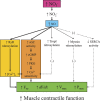Dietary Nitrate Enhances the Contractile Properties of Human Skeletal Muscle
- PMID: 30001275
- PMCID: PMC6138552
- DOI: 10.1249/JES.0000000000000167
Dietary Nitrate Enhances the Contractile Properties of Human Skeletal Muscle
Abstract
Dietary nitrate, a source of nitric oxide (NO), improves the contractile properties of human muscle. We present the hypothesis that this is due to nitrosylation of the ryanodine receptor and increased NO signaling via the soluble guanyl cyclase-cyclic guanosine monophosphate-protein kinase G pathway, which together increase the free intracellular Ca concentration along with the Ca sensitivity of the myofilaments themselves.
Figures

References
-
- Lundberg JO, Weitzberg E, Gladwin MT. The nitrate-nitrite-nitric oxide pathway in physiology and therapeutics. Nat. Rev. Drug Discov. 2008; 7:156–67. - PubMed
-
- Larsen FJ, Ekblom B, Sahlin K, Lundberg JO, Weitzberg E. Effects of dietary nitrate on blood pressure in healthy volunteers. N. Engl. J. Med. 2006; 355:2792–3. - PubMed
-
- Larsen FJ, Weitzberg E, Lundberg JO, Ekblom B. Effects of dietary nitrate on oxygen cost during exercise. Acta. Physiol. (Oxf.). 2007; 191:59–66. - PubMed
-
- Pawlak-Chaouch M, Boissière J, Gamelin FX, Cuvelier G, Berthoin S, Aucouturier J. Effect of dietary nitrate supplementation on metabolic rate during rest and exercise in human: a systematic review and a meta-analysis. Nitric Oxide. 2016; 53:65–76. - PubMed
Publication types
MeSH terms
Substances
Grants and funding
LinkOut - more resources
Full Text Sources
Other Literature Sources
Medical

